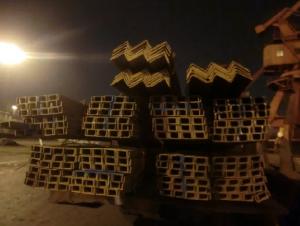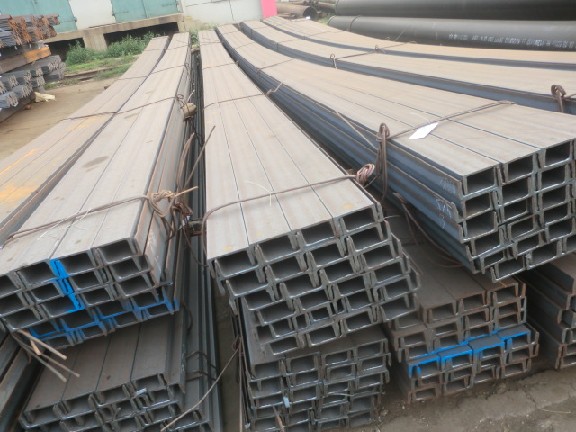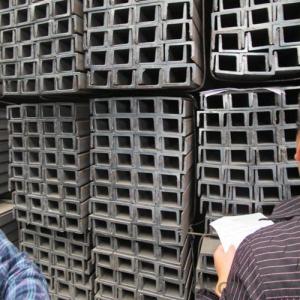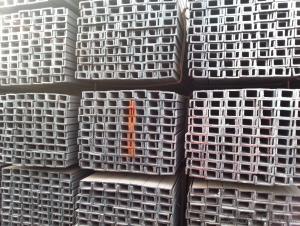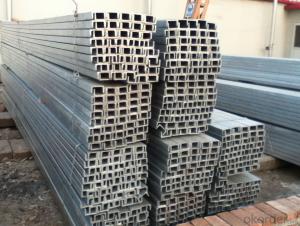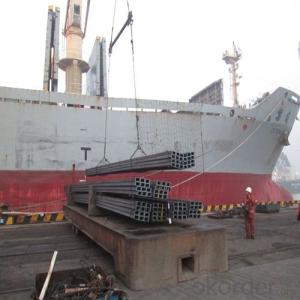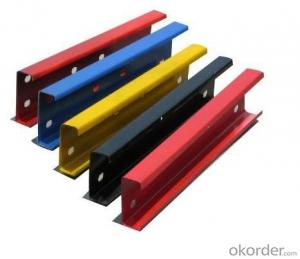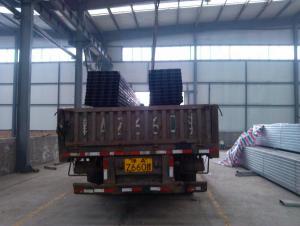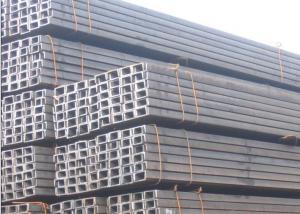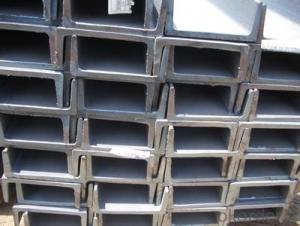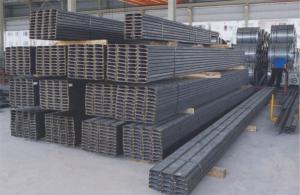JIS U- channel GB U-channel
- Loading Port:
- China Main Port
- Payment Terms:
- TT or LC
- Min Order Qty:
- -
- Supply Capability:
- -
OKorder Service Pledge
OKorder Financial Service
You Might Also Like
Product Description:
OKorder is offering U-channel at great prices with worldwide shipping. Our supplier is a world-class manufacturer of steel, with our products utilized the world over. OKorder annually supplies products to European, North American and Asian markets. We provide quotations within 24 hours of receiving an inquiry and guarantee competitive prices.
Product Applications:
1.The JIS channel can be devided into two kinds, namely common channel steel and light channel steel. The sizes of hot rolled common channel steel range from 5# to 40#. Meanwhile, the channel steel can be divided into cold forming sectional equal channel steel, cold forming sectional unequal channel steel, cold forming inner edge channel steel and outer edge channel steel.
2.The JIS channel is usually used for arch-itechtural structure, and they could be welded in order to support or hang a vari-ety of facilities. They are also usually used in combination with I beam. The channel steel with sizes under 14# is usually applied to construction engineering, as purline, while the channel steel with sizes above 16# is more likely to be used in building vehicle chassis structure and mechanical structure. Furthermore, the channel steel in sizes above 30# are target at building bridge structure, as tension bar.
3.In a word, the channel steel must possess perfect welding property, riveting property and mechanical property and so on.
.
Product Advantages:
OKorder's U-channel are durable, strong, and resist corrosion.
Main Product Features:
· Premium quality
· Prompt delivery & seaworthy packing (30 days after receiving deposit)
· Corrosion resistance
· Can be recycled and reused
· Mill test certification
· Professional Service
· Competitive pricing
Product Specifications:
1. We are definitely speciallizing in manufacturing and supplying channel steel as per japanese standard, which is characterised with high mechanical strength and competitive prices.
2. The sections in details are as followings in the table-1
JIS CHANNEL | Standard h | Sectional b | Dimension s | t | Mass: Kg/m |
| (mm) | (mm) | (mm) | (mm) |
|
50x25 | 50 | 25 | 3.0 | 6.00 | 2.37 |
75X40 | 75 | 40 | 3.8 | 7.00 | 5.30 |
75X40 | 75 | 40 | 4.0 | 7.00 | 5.60 |
75X40 | 75 | 40 | 4.5 | 7.00 | 5.85 |
75X40 | 75 | 40 | 5.0 | 7.00 | 6.92 |
|
|
|
|
|
|
100X50 | 100 | 50 | 3.8 | 6.00 | 7.30 |
100X50 | 100 | 50 | 4.2 | 6.00 | 8.03 |
100X50 | 100 | 50 | 4.5 | 7.50 | 8.97 |
100X50 | 100 | 50 | 5.0 | 7.50 | 9.36 |
|
|
|
|
|
|
125X65 | 125 | 65 | 5.2 | 6.80 | 11.66 |
125X65 | 125 | 65 | 5.3 | 6.80 | 12.17 |
125X65 | 125 | 65 | 5.5 | 8.00 | 12.91 |
125X65 | 125 | 65 | 6.0 | 8.00 | 13.40 |
|
|
|
|
|
|
150x75 | 150 | 75 | 5.5 | 7.30 | 14.66 |
150x75 | 150 | 75 | 5.7 | 10.00 | 16.71 |
150x75 | 150 | 75 | 6.0 | 10.00 | 17.90 |
150x75 | 150 | 75 | 6.5 | 10.00 | 18.60 |
150x75 | 150 | 75 | 6.5 | 10.00 | 24.00 |
|
|
|
|
|
|
200X80 | 200 | 80 | 7.5 | 11.00 | 24.60 |
FAQ:
Q1: Why buy Materials & Equipment from OKorder.com?
A1: All products offered byOKorder.com are carefully selected from China's most reliable manufacturing enterprises. Through its ISO certifications, OKorder.com adheres to the highest standards and a commitment to supply chain safety and customer satisfaction.
Q2: How do we guarantee the quality of our products?
A2: We have established an advanced quality management system which conducts strict quality tests at every step, from raw materials to the final product. At the same time, we provide extensive follow-up service assurances as required.
Q3: How soon can we receive the product after purchase?
A3: Within three days of placing an order, we will begin production. The specific shipping date is dependent upon international and government factors, but is typically 7 to 10 workdays.
Images:
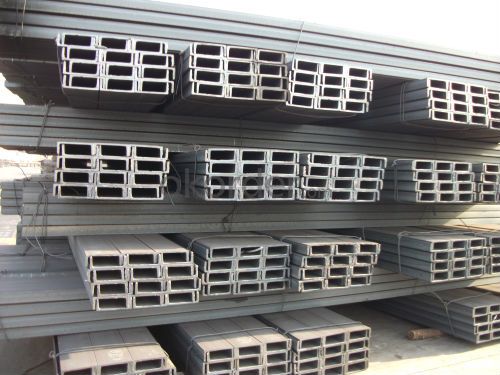
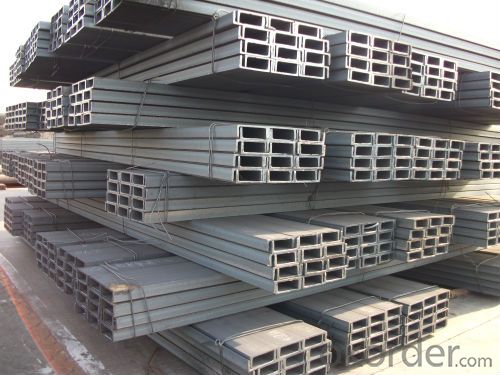
- Q: What are the factors that affect the price of steel channels?
- There are several factors that can impact the price of steel channels. 1. Raw material costs: The price of steel channels is heavily influenced by the cost of raw materials, particularly steel. Fluctuations in the price of iron ore, coal, and other materials used in steel production can directly affect the cost of manufacturing steel channels. 2. Supply and demand: The overall demand for steel channels in the market can impact their price. If demand is high and supply is limited, prices are likely to increase. Conversely, if demand is low and there is excess supply, prices may decrease. 3. Manufacturing and processing costs: The cost of producing steel channels, including labor, energy, and equipment expenses, can impact the final price. Higher manufacturing costs may lead to higher prices for steel channels. 4. Market competition: The level of competition among steel channel manufacturers can also influence prices. When there are multiple producers offering similar products, they may engage in price competition to attract customers, resulting in lower prices. Conversely, if there are fewer suppliers or if they have a unique product, prices may be higher. 5. Transportation and logistics: The cost of transporting steel channels from manufacturing facilities to distribution centers or end-users can impact the final price. Factors such as fuel prices, shipping distances, and transportation infrastructure can all affect transportation costs, which may be passed on to the buyer. 6. Government regulations and tariffs: Trade policies, import duties, and government regulations can also affect the price of steel channels. Tariffs imposed on imported steel channels can increase their price, while government subsidies or support can lead to lower prices. 7. Economic conditions: Overall economic conditions, both globally and domestically, can have an impact on steel channel prices. Factors such as economic growth, inflation, and currency exchange rates can all influence the cost of steel channels. It is important to note that these factors are interrelated and can vary depending on the specific market dynamics and location. Therefore, understanding these factors and their potential impact is crucial for buyers and sellers in the steel channel industry.
- Q: What are the different design considerations for steel channels?
- There are several important design considerations to keep in mind when working with steel channels. Firstly, it is crucial to consider the load-bearing capacity of the steel channel. This includes understanding the maximum weight or force that the channel will need to support, as well as any potential dynamic loads that may be applied. This information is necessary to ensure that the channel is designed with the appropriate dimensions and material strength to safely support the intended load. Secondly, the structural stability of the steel channel must be taken into account. This involves considering factors such as the channel's length, the presence of any lateral bracing or connections, and the overall structural system it will be a part of. Proper design and detailing of connections and bracing are essential to prevent buckling or failure due to instability. Another important consideration is the corrosion resistance of the steel channel. Depending on the environment in which it will be used, measures may need to be taken to protect the channel from corrosion, such as applying protective coatings or using corrosion-resistant materials. Failure to adequately address this consideration can lead to premature deterioration and reduced structural integrity. Additionally, fire resistance is a crucial consideration when designing steel channels. Depending on the application and building codes, fire-resistant coatings or fireproofing measures may need to be incorporated to ensure the channel maintains its structural integrity in the event of a fire. Lastly, aesthetic considerations may also come into play, especially in architectural applications. Designers may need to consider the desired appearance, finish, or surface treatment of the steel channel to ensure it meets the desired aesthetic criteria. Overall, careful consideration of load-bearing capacity, structural stability, corrosion resistance, fire resistance, and aesthetics are all important factors to keep in mind when designing steel channels. By addressing these considerations appropriately, engineers and designers can ensure that the channels will perform safely and effectively in their intended applications.
- Q: Geometrical dimension of channel steel channel 8
- GB: 80*43*5.0 (height * width * thick waist and legs, mm), cross section area: 10.248cm - 10.007kg/m, weight
- Q: How do steel channels contribute to the overall strength of a structure?
- Steel channels contribute to the overall strength of a structure in several ways. Firstly, they provide structural support and stability by distributing the load evenly across the structure. The shape of steel channels, with a wide base and tapered edges, allows for greater weight-bearing capacity and resistance to bending or buckling under heavy loads. Additionally, steel channels enhance the rigidity of a structure by preventing lateral movement or twisting. They act as beams, creating a framework that resists deformation and ensures the structure maintains its shape and integrity even in challenging conditions, such as during earthquakes or high winds. Moreover, steel channels can be strategically placed in critical areas of a structure, such as load-bearing walls or columns, to reinforce these vulnerable points. By reinforcing these areas, the steel channels increase the overall strength and durability of the structure, reducing the risk of structural failure. Furthermore, steel channels have high tensile strength, which means they can resist stretching or elongation under tension. This property is crucial for structures that experience dynamic loads, such as bridges or high-rise buildings. Steel channels help to distribute and absorb these dynamic forces, preventing excessive deflection or deformation that could compromise the structure's stability. In summary, steel channels contribute to the overall strength of a structure by providing structural support, enhancing rigidity, reinforcing vulnerable points, and offering high tensile strength. Their ability to distribute loads, resist bending or buckling, and withstand dynamic forces makes them a vital component of any robust and durable structure.
- Q: How do steel channels contribute to the overall sustainability of a structure?
- Steel channels contribute to the overall sustainability of a structure in several ways. First and foremost, steel is a highly durable and long-lasting material. It is resistant to corrosion, weathering, and degradation, which means that structures built with steel channels have a longer lifespan compared to structures made with other materials. This durability reduces the need for frequent repairs or replacements, ultimately reducing the environmental impact associated with construction and demolition waste. Additionally, steel channels are lightweight yet strong, allowing for efficient use of materials. This means that less steel is required to achieve the same structural strength, leading to reduced resource consumption and energy usage during the manufacturing process. Moreover, steel is a recyclable material, and steel channels can be easily repurposed or recycled at the end of their life cycle. Recycling steel reduces the demand for new raw materials and saves energy that would be required in the production of new steel. Furthermore, steel channels offer design flexibility and versatility, enabling architects and engineers to create innovative and sustainable structures. Steel channels can be easily shaped, welded, and assembled, facilitating the construction process and allowing for a wide range of architectural designs. This flexibility also allows for future modifications or expansions without requiring extensive demolition or reconstruction. Lastly, steel channels have excellent fire resistance properties. Steel is non-combustible and does not contribute to the spread or intensity of fires, which enhances the safety of the structure and reduces the risk to occupants and neighboring buildings. In summary, steel channels contribute to the overall sustainability of a structure through their durability, efficient use of materials, recyclability, design flexibility, and fire resistance. By choosing steel channels, we can create structures that are not only environmentally friendly but also safe, long-lasting, and cost-effective in the long run.
- Q: How is the hollow tempered glass mounted on the channel steel?
- Hollow two pieces of glass, there are 4 faces, from outdoor to indoor is defined as 1-4, Low-E glass film surface can only be in the cavity, that is, can only be second or third.Colorless, highly permeable Low-E is placed on third sides (Low-E glass indoors), colored on second sides (Low-E glass outside).In order to prevent the broken glass debris, doubling down side must. Because qualified laminated glass is not damaged when the debris generated, is still able to maintain its integrity.
- Q: How do steel channels perform in extreme temperature variations?
- Steel channels are known for their excellent performance in extreme temperature variations. The unique properties of steel, such as its high melting point and thermal conductivity, allow steel channels to withstand extreme temperatures without significant deformation or damage. In high-temperature environments, steel channels exhibit remarkable stability and strength. They can resist the effects of thermal expansion and contraction, which can cause other materials to warp or crack. The thermal conductivity of steel also allows for efficient heat transfer, which helps in dissipating excess heat and maintaining the structural integrity of the channels. Similarly, in low-temperature conditions, steel channels remain robust and do not become brittle like some other materials. This is due to the ductility of steel, which enables it to withstand the stresses caused by temperature changes without fracturing or breaking. Additionally, steel channels can maintain their shape and structural integrity even in extremely cold environments, making them highly suitable for various applications. Overall, steel channels have proven to be reliable and perform exceptionally well in extreme temperature variations. Whether it is enduring high temperatures or withstanding freezing conditions, steel channels are a preferred choice due to their strength, stability, and ability to resist thermal expansion and contraction.
- Q: Can steel channels be used for supporting rooftop equipment?
- Indeed, rooftop equipment can be supported by steel channels. Thanks to their strength and durability, steel channels are well-suited for bearing the weight of rooftop equipment, including HVAC units, solar panels, or communication antennas. By offering stability and support, they effectively ensure the secure placement of such equipment. Furthermore, steel channels can be tailored to meet specific dimensions and requirements, thereby proving to be a versatile choice for a wide range of rooftop equipment installations.
- Q: How do steel channels contribute to building aesthetics?
- Steel channels can contribute to building aesthetics by providing clean lines and a modern, industrial look. They can be used to create visually appealing designs, such as exposed beams or frames, that add a unique and contemporary element to the overall appearance of the building. Additionally, steel channels offer versatility in terms of shape and size, allowing architects and designers to create various architectural features that enhance the overall aesthetic appeal of the structure.
- Q: What are the different finishes available for steel channels?
- There are several different finishes available for steel channels, including hot-dip galvanized, painted, powder coated, and stainless steel. Each finish offers unique benefits in terms of corrosion resistance, aesthetics, and durability. Hot-dip galvanized channels are coated with a layer of zinc to protect against rust and are commonly used in outdoor and industrial applications. Painted channels offer a decorative finish and can be customized to match specific color requirements. Powder coated channels have a durable and chip-resistant finish and are often used in architectural and decorative applications. Stainless steel channels provide excellent corrosion resistance and are suitable for applications requiring high strength and hygiene standards.
Send your message to us
JIS U- channel GB U-channel
- Loading Port:
- China Main Port
- Payment Terms:
- TT or LC
- Min Order Qty:
- -
- Supply Capability:
- -
OKorder Service Pledge
OKorder Financial Service
Similar products
Hot products
Hot Searches
Related keywords
